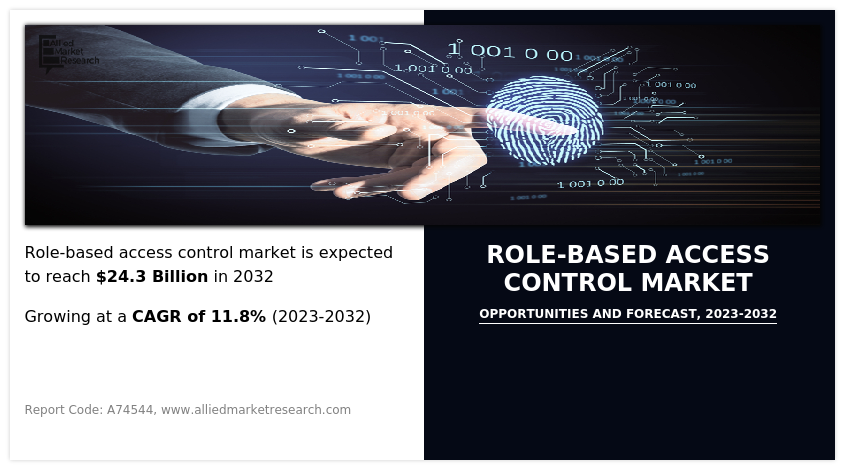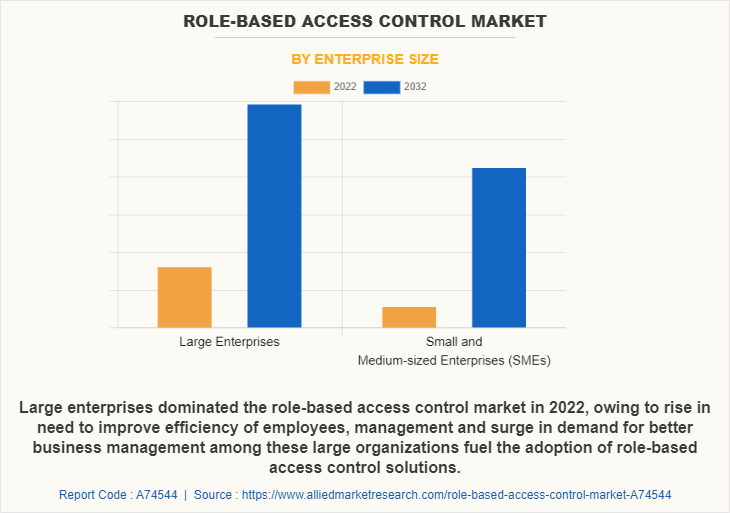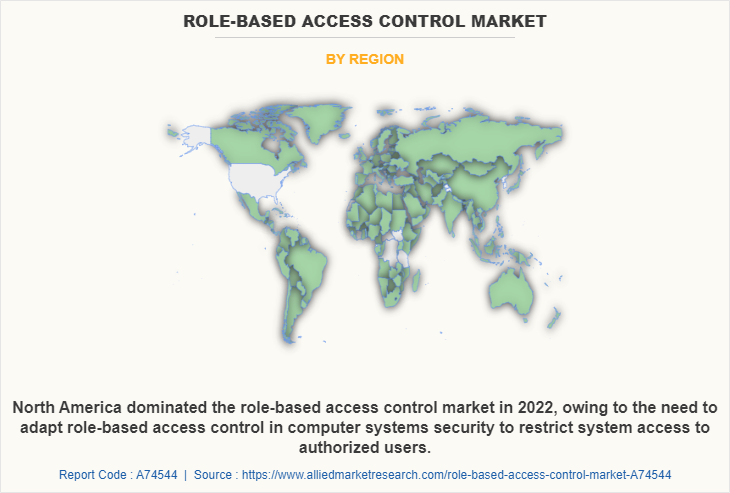Role-based Access Control Market Statistics, 2032
The global role-based access control market was valued at $8.3 billion in 2022, and is projected to reach $24.3 billion by 2032, growing at a CAGR of 11.8% from 2023 to 2032.
Factors such as growth in digitalization and increase in adoption of bring your own device (BYOD) are positively impacting the growth of the market. In addition, an increase in adoption of role-based access control model across businesses to enhance productivity is expected to fuel the growth of the role-based access control market for the future. Furthermore, an increase in investments in advanced technologies such as AI, ML, cloud-based services and IoT is expected to provide lucrative growth opportunities for the market during the forecast period. Moreover, role-based access control (RBAC) solutions help reduce costs over the entire lifecycle and create numerous opportunities for the market growth in the upcoming years. However, inaccessible data security, and lack of skills, hamper the growth of the role-based access control market.

Role-based access control (RBAC) is a security approach that authorizes and restricts system access to users based on their roles within an organization. This allows users to access the data and applications needed to fulfill their job requirements and minimizes the risk of unauthorized employees accessing sensitive information or performing unauthorized tasks. In addition to restricting access, RBAC can refine the way a user interacts with data permitting read-only or read/write access to certain roles, thus limiting a user’s ability to execute commands or delete information.
Furthermore, an effective system of user access control is essential for large organizations or companies that manage a large number of contractors, vendors, and even customers. For these organizations, RBAC will protect critical data, improve operational efficiency, and help certify regulatory compliance. Such factors are expected to provide lucrative growth opportunities for the role-based access control market during the forecast period.
Moreover, the emerging role-based access control models are adopted by various industries such as healthcare, IT, retail, and other sectors, to fulfill the evolving challenges in businesses. RBAC provides fine-grained control, offering a simple, manageable approach to access management that is less error-prone than individually assigning permissions.
Segment Review
The role-based access control market is segmented into component, model type, enterprise size, industry vertical, and region. By component, it is bifurcated into solution and services. By model type, it is divided into core RBAC, hierarchical RBAC and constrained RBAC. By enterprise size, the market is segregated into small & medium-sized enterprises (SMEs) and large enterprises. By industry vertical, the role-based access control market is classified into BFSI, IT & telecom, government & defense, retail & consumer goods, education, healthcare, energy and utilities and others. Region wise, it is analyzed across North America, Europe, Asia-Pacific, and LAMEA.

On the basis of enterprise size, the large enterprise segment dominated the role-based access control market share in 2022 and is expected to continue this trend during the forecast period. Surge in adoption of role-based access control in large businesses opens numerous opportunities for the role-based access control market growth. However, the small & medium-sized enterprises (SMEs) is expected to experience the fastest growth in the coming years. Factors such as surge in digitalization and increase in government initiatives through various digital SME campaigns throughout the world fuel the growth of the role-based access control industry.

By region, North America dominated the market share in 2022 for the role-based access control market. The increasing investment in advanced technologies such as cloud-based services and role-based access control to improve businesses and the customer experience are anticipated to propel the growth of the market. However, Asia-Pacific is expected to exhibit the highest growth during the forecast period. This is attributed to increase in penetration of digitalization and higher adoption of advanced technology are expected to provide lucrative growth opportunities for the role-based access control market in this region.
Top Impacting Factors
Increase in adoption of remote work policy:
Remote work has already gained substantial popularity among various enterprises but with emergence of the COVID-19 pandemic, many enterprises were forced to switch to work-from-home mechanism. This mechanism is helping prevent large-scale transmission of viruses to a considerable extent. Furthermore, a large number of companies have many employees working from home. The threat of data breaches has increased, owing to remote work mechanisms. Hence, to overcome these problems, many enterprises are adopting RBAC solutions to tackle such problems, which eventually boosts the growth prospects.
Furthermore, enterprises are continuously involved in product innovation processes. For instance, in March 2021, Cisco Systems Inc., upgraded its intent-based networking services to help communication service providers and web scale companies around the world to connect, secure and automate their networks to deliver a stronger, more accessible internet to everyone, everywhere, regardless of geographic limitations. Such enhancements further propel the growth of the role-based access control market during the forecast period.
Leveraging integrations for smart automation:
Automation is one of the most under-utilized access control tech trends. While integrated systems were popular access control technology trends in recent years, new developments and access control tech trends have opened the door to automating operations for greater efficiency. By connecting what used to be disparate building systems such as access control, parking management, room scheduling, visitor management and tenant experience apps, automations streamline processes to make operations more efficient. Instead of logging into and configuring different building systems, integration allows building managers to control all interface. Integrated building management systems not only creates better workplace experiences, but it can also increase ROI across an entire enterprise.
For instance, it is also expected to see more organizations take advantage of artificial intelligence for integrated security. AI-enhanced access control and video technology can help security personnel identify potential threats faster and with better accuracy. By helping teams, AI-powered security technology can reduce human error, and improve overall experiences. In addition, these role-based access control market trends allow teams to manage a greater number of users with less drain on resources.
COVID-19 Impact Analysis
The effects of the COVID-19 pandemic on the global economy boosted the growth of the role-based access control market owing to increase in trend of work from home model that compelled employers to use role-based access systems to keep corporate data and network safe. The role-based access control market witnessed a significant upturn, owing to the continued surge in demand for wireless systems and security systems, specifically in the information and communication sector.
In addition, post-COVID-19 situation, companies also focused on emerging technologies such as cloud computing technology, internet of things, and machine learning-based solutions, among others, to provide role-based security that assigns permissions to end-users based on their role within the organization. As a result, companies enhanced their role-based access control services to strengthen their position in the role-based access control market.
For instance, in April 2022, Amazon Web Services Inc's platform Amazon Redshift enhanced its role-based access control service and supports role-based access control that helps to simplify the management of security privileges in Amazon Redshift. The role-based access control enhanced feature includes control end user access to data at a broad or granular level based on their job role/permission rights and level of data sensitivity.
Moreover, the widespread adoption of role-based access control increased in businesses and warehouses during the pandemic, where access permissions are determined according to the roles the users have within the warehouse. As a result, companies enhanced and upgraded their role-based access control services to strengthen their position in the role-based access control market.
For instance, in March 2023, Amazon Web Services Inc's platform Amazon Redshift upgraded its role-based access control that supports up to 200K tables for Redshift Serverless and for data warehouse clusters. This feature is intended for customers with workloads that require a large number of tables to run with Amazon Redshift without having to split the tables across multiple warehouses. Such factors expected to grow of role-based access control market forecast.
Key Strategies/Development:
- In February 2023: ForgeRock enhanced its role-based access control and solutions that support authorization policies from simple, coarse-grained rules to highly advanced, fine-grained entitlements. Organizations can ensure that just the right amount of access control is given to each consumer and workforce.
- In January 2023: Microsoft Corporation's 365 Defender role-based access control model extended detection and response solution enhanced its services for security admins to centrally manage privileges across domains. It offers a unified and granular cross-services access permission model to help the security operations center increase productivity across various Microsoft defender products.
- In July 2022: Oracle Corporation and Microsoft Corporation collaborated for the enhancement of role-based access control service and also launched Oracle database service for Microsoft Azure. With this new offering, Microsoft Azure customers can easily provide, access, and monitor enterprise-grade Oracle database services in Oracle Cloud Infrastructure (OCI) with familiar experience.
- In March 2022: Oracle created a new form of free Solaris that provides enhanced role-based access control service. The new cut of the OS is called a common build environment (CBE). The free offering is aimed at open-source software developers, or non-production personal use, and is offered under Oracle's early adopter license.
Key Benefits for Stakeholders
- The study provides an in-depth role-based access control market analysis along with the current trends and future estimations to elucidate the imminent investment pockets.
- Information about key drivers, restraints, and opportunities and their impact analysis on the role-based access control market size is provided in the report.
- The Porter’s five forces analysis illustrates the potency of buyers and suppliers operating in the role-based access control industry.
- The quantitative analysis of the global role-based access control market for the period 2022–2032 is provided to determine the role-based access control market potential.
Role-based Access Control Market Report Highlights
| Aspects | Details |
| Market Size By 2032 | USD 24.3 billion |
| Growth Rate | CAGR of 11.8% |
| Forecast period | 2022 - 2032 |
| Report Pages | 403 |
| By Component |
|
| By Model Type |
|
| By Enterprise Size |
|
| By Industry Vertical |
|
| By Region |
|
| Key Market Players | BeyondTrust Corporation, ForgeRock, JumpCloud Inc., IBM Corporation, Microsoft Corporation, Ping Identity, Oracle Corporation, Amazon Web Services Inc., SolarWinds Worldwide, LLC, Okta |
Analyst Review
According to CXOs of the leading companies, over time, businesses have seen various changes in the business processes, operations, and industrial automation. Moreover, businesses are shifting toward the digital platform and increasing implementation of Industry 4.0 to cope with ongoing tough business competition, and rising security concern, creates the need for seamless solution to meet these requirements. This eventually increases the adoption of role-based access control in industry rapidly. Furthermore, advanced technologies such as artificial intelligence (AI), machine learning (ML) technologies, cloud computing and big data have become more widely used in various sector such as BFSI, healthcare and others, is expected to provide the lucrative opportunities for the market growth during the forecast period.
Moreover, role-based access control allows organizations to improve their security posture and comply with security regulations. However, implementing role-based access control across an entire organization can be complex. Furthermore, the role-based access control model is advancing quite rapidly the rising development of role-based access control model will trigger investments in businesses. Moreover, RBAC systems can streamline and automate many transactions and business processes and provide users with the resources to perform their jobs better, faster and with greater personal responsibility. With the RBAC system implemented, organizations are better positioned to meet their own statutory and regulatory requirements for privacy and confidentiality, which is crucial for organizations and financial institutions. Due to this, directors, managers and IT staffers are better able to monitor how data is being used and accessed, for the purpose of preparing more accurate planning and budget models based on real needs.
Nevertheless, prominent market players are exploring new technologies and applications to meet the increase in customer demands. Product launches, collaborations, and acquisitions are expected to enable them to expand their product portfolios and penetrate different regions. Emerging economies provide lucrative opportunities to market players for growth or expansion. For instance, in February 2023, Huawei Technologies Co., Ltd. launched the digital managed network solution to boost intent-based networking and growth for carriers' B2B services. This solution provides digital managed network capabilities and rich product portfolios, helping carriers transform from ISPs to MSPs.
Global Role-based Access Control is Expected to Reach $24,273.61 Million by 2032.
The North America is the largest market for the Role-based Access Control.
Factors such as increase in adoption of role-based access control model across businesses to enhance productivity is expected to fuel the growth of the market for the future.
The key growth strategies for RBAC include product portfolio expansion, acquisition, partnership, merger, collaboration and others.
Ping Identity, Microsoft Corporation, Oracle Corporation, SolarWinds Worldwide, LLC, IBM Corporation, BeyondTrust Corporation, Amazon Web Services Inc. and others.
Loading Table Of Content...
Loading Research Methodology...



